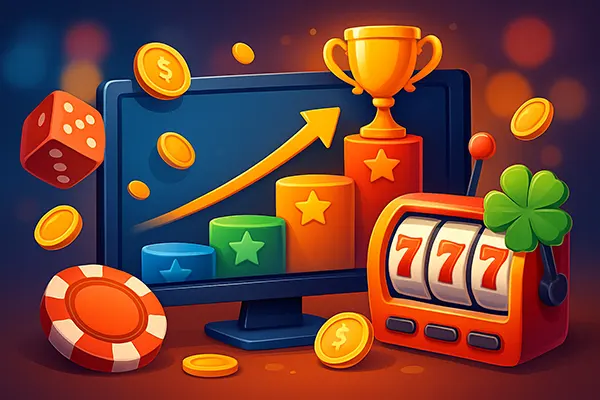How Online Casinos Use Gamification: Quests, Levels, and Rewards
Gamification has become a key strategy in the online casino industry, helping to transform passive gameplay into an engaging, goal-oriented experience. By integrating game-like elements such as levels, quests, and rewards, platforms aim to boost user engagement and retention. As of February 2025, this trend continues to gain momentum, offering players structured progression and personal incentives to remain active on a site.
Quests and Missions: Making Play Purposeful
Online casinos frequently introduce daily, weekly, or seasonal quests that challenge users to complete specific tasks. These may include spinning a particular slot a number of times, achieving a win streak, or trying new game releases. Players who complete quests are typically rewarded with free spins, loyalty points, or entries into exclusive prize draws.
One of the most effective examples of this mechanic is the use of progressive missions, where each completed task unlocks the next. This step-by-step approach keeps players motivated to continue playing while introducing them to various parts of the platform’s ecosystem. Operators such as Mr Green and Casumo have been pioneers in gamified quests.
Quests not only create a sense of accomplishment but also provide variety and structure in what would otherwise be repetitive gameplay. For many players, the sense of direction that quests offer is just as valuable as the rewards themselves.
How Quests Influence User Behaviour
Studies show that structured objectives lead to longer session times and higher player retention. Gamified missions guide users toward trying new features, reducing churn caused by boredom or lack of novelty. This behavioural design enhances the player’s emotional connection with the brand.
By tracking progress, online casinos can also personalise the experience. Adaptive quest systems that modify challenges based on a player’s habits increase perceived fairness and engagement. These intelligent mechanics are more common now thanks to AI-based backend systems integrated by leading operators in 2025.
As a result, gamified systems are not only a retention tool but also a method for refining player segmentation and marketing efficiency, creating a feedback loop of behavioural data and tailored experiences.
Level Systems: Encouraging Long-Term Involvement
Level-based loyalty programs are now widespread across most regulated online casinos. They reward users for cumulative play, with points earned through deposits, bets, and achievements. As players climb levels, they unlock better bonuses, increased cashback rates, and even access to exclusive games or VIP support tiers.
Each level in the hierarchy typically has a name, visual theme, and progression meter. For example, a user might move from ‘Rookie’ to ‘Elite’ status with continued gameplay. This transparent system of progression taps into basic psychological motivators such as mastery and achievement.
Importantly, these systems are often integrated with visual cues like progress bars and badge collections to reinforce user progress. This adds an additional layer of gratification and motivates continued involvement, especially in mobile-first interfaces.
Real-Time Progress and Customisation
Many platforms now display real-time stats that show how close a player is to the next level. This has proven more effective than periodic email updates in maintaining player interest. Custom avatars and profile customisation features are also unlocked with level progression, allowing users to express their gaming identity.
Operators like Unibet and LeoVegas have introduced customisable dashboards that reflect a player’s journey and achievements. These dashboards are not only visually appealing but also act as engagement hubs where players can track bonuses, unlocks, and upcoming challenges.
Furthermore, the integration of social features – such as leaderboards or friend comparisons – has turned level systems into a more communal experience, blending elements of competitive and cooperative play.

Reward Mechanics: Beyond Simple Bonuses
Gamification rewards are more sophisticated than traditional deposit bonuses. Casinos now use layered reward systems that include mystery boxes, spin-the-wheel bonuses, and randomised prizes triggered by non-monetary events. This unpredictability encourages repeated interactions and enhances user loyalty.
Reward calendars are another popular tool. These offer daily surprises such as free spins, loyalty multipliers, or even physical gifts for high-stakes players. February 2025 data shows a 25% increase in retention among platforms using multi-day login incentives.
More advanced systems apply dynamic rewards based on user behaviour. For instance, if a player frequently plays live blackjack, the casino may offer exclusive tournaments or cashback specific to that category. This fine-tuned personalisation builds brand loyalty.
Combining Rewards with Responsible Gaming
In line with increased regulatory scrutiny, many operators ensure that reward systems are aligned with responsible gaming practices. Players can set daily session limits or self-exclude from promotions while still engaging with the gamified environment.
Additionally, new tools allow players to track not only their spending but also their reward progress in relation to budgeted time. This transparency helps reduce compulsive behaviours while preserving enjoyment.
By 2025, compliance-friendly gamification has become a competitive advantage. Platforms that successfully merge player safety with excitement earn stronger reputations and attract more long-term users, particularly in European markets with strict gambling regulations.
